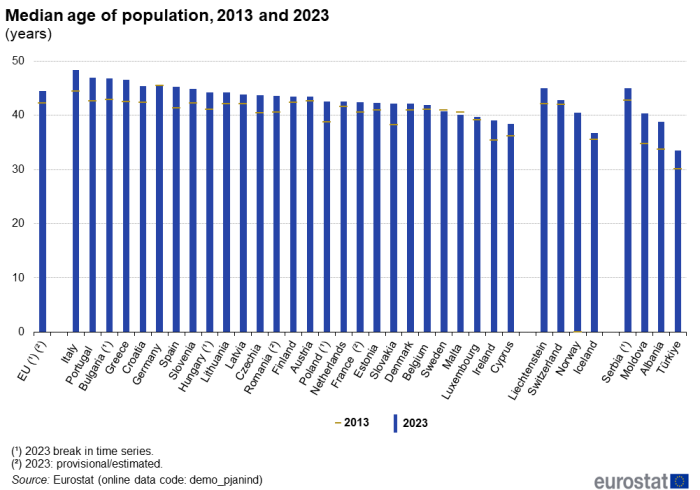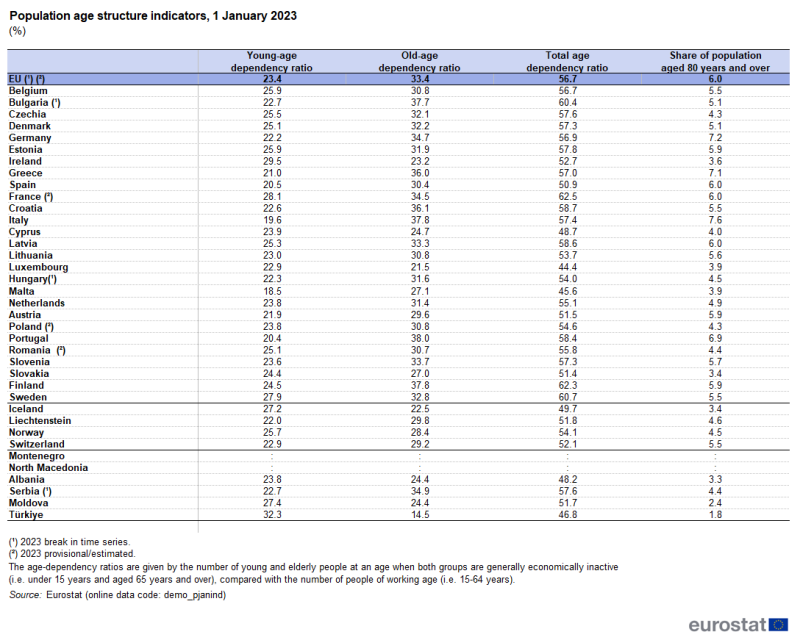Population structure and ageing
Data extracted in February 2024.
Planned article update: February 2025.
Highlights
Increase in the share of the population aged 65 years and over between 2013 and 2023
This article looks at the impact of demographic ageing within the European Union (EU), which is likely to be of major significance in the coming decades. Consistently low birth rates and higher life expectancy are transforming the shape of the EU's age pyramid. Probably the most important change will be the marked transition towards a much older population structure, a development that is already apparent in several EU Member States.
As a result of demographic change, the proportion of people of working age in the EU is shrinking while the relative number of those retired is expanding. The share of older people in the total population is expected to increase significantly in the coming decades. This may, in turn, lead to an increased burden on those of working age to provide for the social expenditure required by the ageing population for a range of related services.
Full article
The population of the EU on 1 January 2023 was estimated at 448.8 million people. Children of age between 0 and 14 years made up 14.9 % of the EU's population (see Table 1), while people considered to be of working age (15 to 64 years) accounted for 63.8 % of the population. Older people (aged 65 years and over) had a 21.3 % share (an increase of 0.2 percentage points (pp) compared with the previous year and an increase of 3.0 pp compared with 10 years earlier). For comparison, in 2022 the three population groups, children of age between 0 and 14 years (0 to 14 years), working age (15 to 64 years) and older people (aged 65 years and over) represented, respectively, 15.0 %, 63.9 % and 21.1 % of the EU's population.
Across the EU Member States, the highest shares of children of age between 0 and 14 years in the total population in 2023 were observed in Ireland (19.3 %), Sweden (17.4 %) and France (17.3 %), while the lowest shares were recorded in Italy, (12.4 %), Malta (12.7 %) and Portugal (12.9 %). Compared with 2022, only three Member States (Germany, Portugal and Czechia) had an increased share of children of age between 0 and 14 years in the population in 2023, while in the other Member States this share was constant (in Lithuania, Austria, Cyprus, Estonia, Slovakia, Poland, Latvia, Croatia and Luxembourg) or decreased (in the other 15 Member States). Regarding the share of people aged 65 years and over in the total population, Italy (24.0 %), Portugal (24.0 %), Bulgaria (23.5 %), Finland (23.3 %), Greece (23.0 %) and Croatia (22.7 %) had the highest shares, while Luxembourg (14.9 %) and Ireland (15.2 %) had the lowest shares. In 2023, compared with 2022, the share of people aged 65 years and over increased in 20 Member States, while in Estonia, Czechia and Malta it decreased, and in Spain, Lithuania, Hungary and Germany this share remained unchanged.
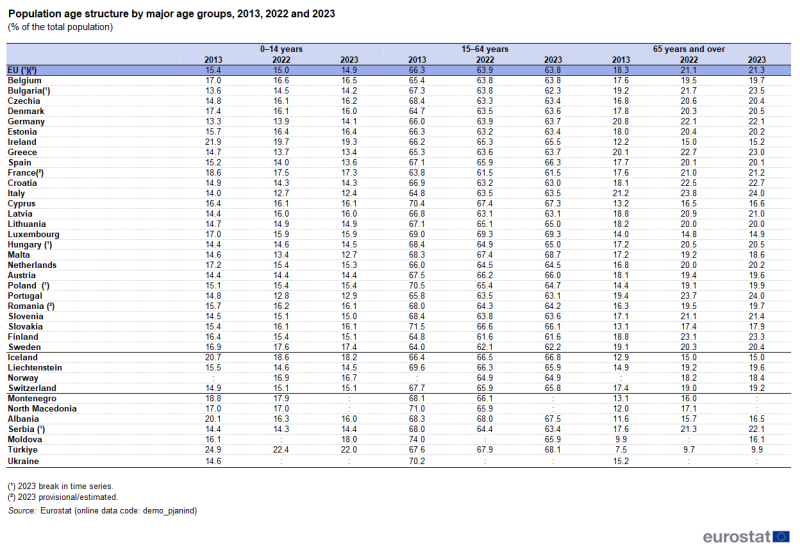
Source: Eurostat (demo_pjanind)
The population structure of the EFTA and candidate countries with data available was similar to that generally observed in the EU, the main exceptions being Iceland (where the population structure was similar to that of Ireland): in this country, the proportion of the youngest age group was high (18.2 %) and people aged 65 years and above accounted for a comparatively low share of the total population (15 %). Türkiye and Moldova also had a relatively low share of people aged 65 years and above (respectively, 9.9 % and 16.1 %). Nevertheless, the trend of population ageing is also visible in these countries (see Figure 1).
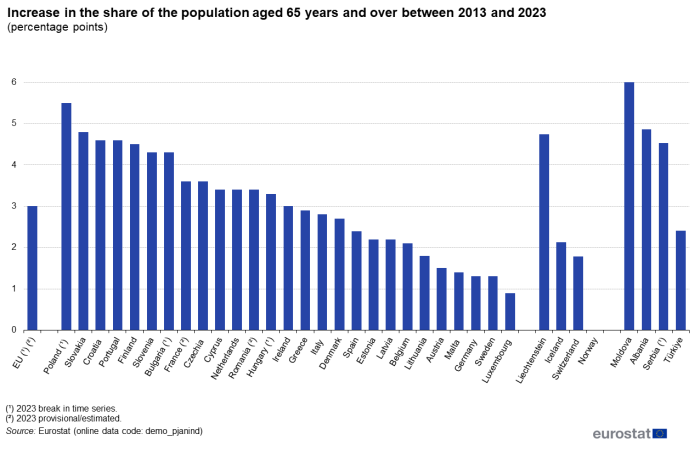
Source: Eurostat (demo_pjanind)
Median age is highest in Italy and lowest in Cyprus
The median age of the EU's population is increasing and was 44.5 years on 1 January 2023 (see Figure 2). This means that half of the EU's population was older than 44.5 years, while the other half was younger. Across the EU Member States the median age ranged between 38.4 years in Cyprus and 48.4 years in Italy, confirming the relatively young and relatively old population structures recorded in each of these Member States.
The median age in the EU increased by 2.3 years (on average by 0.23 years per annum) between 2013 and 2023, rising from 42.2 years to 44.4 in 2022 and 44.5 years in 2023. It increased in almost all EU Member States, rising by 4 or more years in Italy, Slovakia, Spain, Greece and Portugal, but not in Sweden, where it decreased (from 40.9 years in 2013 to 40.8 years in 2023) and Malta (from 40.5 years in 2013 to 40.1 years in 2023). Moldova experienced the largest increase in median age over the past 10 years: this rose by 5.5 years, from 34.8 years in 2013 to 40.3 in 2023 (see Figure 2). Between 2022 and 2023, the median age increased in 15 Member States, in two EFTA countries and in all of the candidate countries for which data are available, while it decreased in Germany, Estonia, Malta, Lithuania, Netherlands, Austria, Latvia, Denmark and Czechia, and was constant in Belgium, Croatia, Luxembourg, Iceland and Norway. The median age recorded in the EFTA and in the available candidate countries in 2023 was lower than the EU figure, except for Liechtenstein and Serbia (both 45.0 years).
Slightly more than three persons of working age for every person aged 65 years and over
Age dependency ratios can be used to study the level of support given to younger and/or older people by the working age population; these ratios are expressed in terms of the relative size of younger and/or older populations compared with the working age population. The old-age dependency ratio for the EU was 33.4 % on 1 January 2023 (see Table 2), with just over three persons of working age for every person aged 65 years and over. The old-age dependency ratio across the EU Member States ranged from lows of 21.5 % in Luxembourg and 23.2 % in Ireland, with almost five working age persons for every person aged 65 years and over, to highs of 38.0 % in Portugal, 37.8 % in Italy and 37.8 % in Finland, where there were fewer than three working age persons for every person aged 65 years and over. Between 2022 and 2023, the old-age dependency ratio increased in 21 Member States while it decreased in Czechia, Estonia, Spain, Hungary and Malta and was constant in Germany.
The combination of young and old-age dependency ratios provides the total age dependency ratio (calculated as the ratio of dependent people, young and old, compared with the population considered to be of working age, in other words 15 to 64 years). In 2023, this was 56.7 % in the EU, indicating that there were approximately two working age persons for every dependent person. The lowest total age dependency ratio among the EU Member States in 2023 was observed in Luxembourg (44.4 %) and the highest in France (62.5 %).
A generally increasing trend can be observed for the EU's old-age and total dependency ratios. The old-age dependency ratio increased by 5.7 pp during the past decade (from 27.7 % in 2013 to 33.4 % in 2023), while the total dependency ratio increased by 5.8 pp over the same period (from 50.9 % in 2013 to 56.7 % in 2023).
Past and future population ageing trends in the EU
Population ageing is a long-term trend that began several decades ago in Europe. This trend is visible in the transformations of the age structure of the population and is reflected in an increasing share of older people, coupled with a declining share of working-age people in the total population.
Population pyramids (see Figures 3 and 4) show the distribution of the population by sex and by five-year age groups. Each bar corresponds to the share of the given sex and age group in the total population (men and women combined). The EU population pyramid on 1 January 2023 is narrow at the bottom and has a rhomboid form due to the 'baby boomer' cohorts resulting from the high fertility rates in several European countries after World War II (known as the 'baby boom'). These 'baby boomers' are now increasing the retirement age population, as illustrated by the comparison with the 2008 population pyramid. The 'baby boom' bulge is moving up the population pyramid, leaving the working-age population and the base narrower — as can be seen in Figure 3.
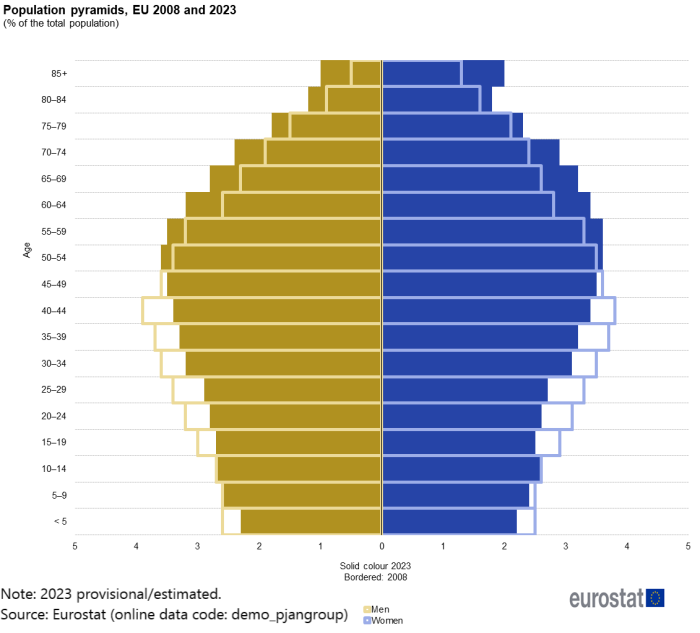
Source: Eurostat (demo_pjangroup)
The share of the population aged 65 years and over is increasing in every EU Member State, EFTA country and in the candidate countries for which data are available. The increase within the last decade ranges from 5.5 pp in Poland, 4.8 pp in Slovakia, 4.6 pp in Portugal and Croatia, and 4.5 pp in Finland, to 1.3 pp in Germany and Sweden and 0.9 pp in Luxembourg. Within the last decade (2013–2023), an increase of 3.0 pp was observed for the EU as a whole (see Figure 1).
The growth in the relative share of older people may be explained by increased longevity, a pattern that has been apparent for several decades as life expectancy has risen, at least until 2019 (see mortality and life expectancy statistics); this development is often referred to as 'ageing at the top' of the population pyramid.
However, consistently low levels of fertility over many years have contributed to population ageing, with fewer births leading to a decline in the proportion of children and young people in the total population (see fertility statistics). This process is known as 'ageing at the bottom' of the population pyramid, and can be observed in the narrowing base of the EU population pyramids between 2008 and 2023.
In an attempt to look at future trends for population ageing, Eurostat updated its population projections at national level in spring 2023 covering the period from 2022 to 2100. The EU's population is projected to increase to a peak of 453.3 million people around 2026 and thereafter gradually decline to 419.5 million people by 2100.
The comparison of age pyramids for 2023 and 2100 (see Figure 4) shows that the EU's population is projected to continue to age. In the coming decades, the number of elderly people will increase significantly. By 2100, the pyramid will take more the shape of a block, narrowing considerably in the middle of the pyramid (around the age 45–54 years).
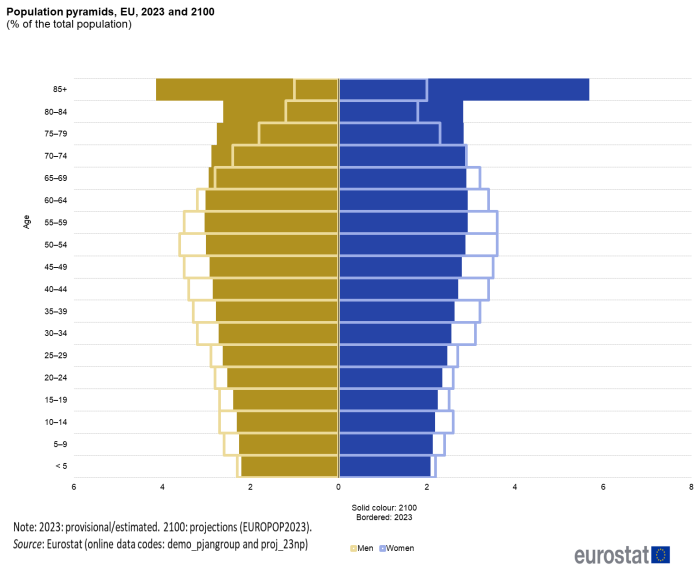
Source: Eurostat (demo_pjangroup) and (proj_23np)
Another aspect of population ageing is the progressive ageing of the older population itself, as the relative significance of the very old is growing at a faster pace than any other age segment of the EU's population. The share of those aged 80 years or above in the EU's population is projected to have a two and a half fold increase between 2023 and 2100, from 6.0 % to 15.3 % (see Figure 5).
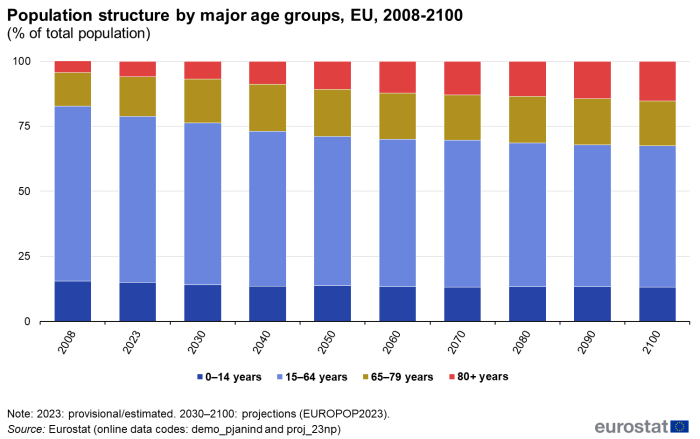
Source: Eurostat (demo_pjanind) and (proj_23np)
During the period from 2023 to 2100, the share of the population of working age is expected to decline, while older people will probably account for an increasing share of the total population: those aged 65 years and over will account for 32.5 % of the EU's population by 2100, compared with 21.3 % in 2023. As a result of the population movement between age groups, the EU's old-age dependency ratio is projected to almost double from 33.4 % in 2023 to 59.7 % by 2100 and the total-age dependency ratio is projected to rise from 56.7 % in 2023 to 83.9 % by 2100 (see Figure 6). The median age is expected to increase by 5.7 years, rising from 44.5 years in 2023 to 50.2 years in 2100.
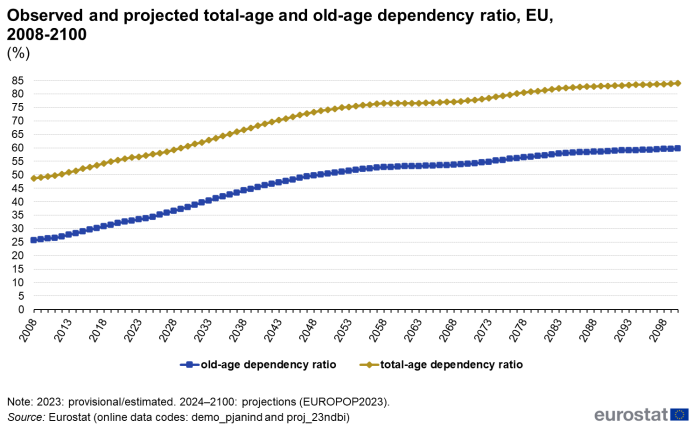
(%)
Source: Eurostat (demo_pjanind) and (proj_23ndbi)
Source data for tables and graphs
Data sources
Eurostat collects data from EU Member States and other countries participating in its demography data collection exercise in relation to populations as of 1 January each year. The recommended definition is the 'usually resident population' and represents the number of inhabitants of a given area on 1 January of the year in question (or, in some cases, on 31 December of the previous year). In accordance with the United Nations international recommendations, the definition of 'usual residence' is based on a 12 month reference period, in other words, those included should have lived in their place of usual residence for a continuous period of at least 12 months before the reference date, or arrived in their place of usual residence during the 12 months before the reference date with the intention of staying there for at least one year. However, countries may report to Eurostat population figures based on the registered or legal population.
Eurostat provides information for a wide range of demographic data. Data on population includes breakdowns by several characteristics, such as age, sex, marital status and educational attainment.
Eurostat produces long-term population projections at a national and regional level every three years, since 2022 short-term annual updates between their releases. These projections are 'what-if' scenarios that aim to provide information about the likely future size and age structure of the population based on assumptions of future trends in fertility, life expectancy and migration.
Methodological notes:
- Following Eurostat's recommendations to ensure consistency of statistics over time, several Member States (Bulgaria, Germany, Ireland, Greece, Spain, Croatia, Italy, Cyprus, Lithuania, Hungary, Malta, Poland, Portugal) have revised or are in process of revising their population time series between the reference years of the population and housing censuses held in 2011 and 2021. While this work is spread over time, revisions are mostly expected in the first quarter of 2024.
- The break of time series for Bulgaria, Hungary and Poland on 1 January 2023 is due to the implementation of the 2021 population and housing censuses.
Context
A number of important policies, notably in social and economic fields, use demographic data for planning, monitoring and evaluation programmes — for example, population ageing and its likely effects on the sustainability of public finances and welfare provision, or the economic and social impact of demographic change.
The EU has been going through a period of demographic and societal change. The outbreak of the COVID-19 pandemic will leave a lasting impact on the way we live and work together. The outbreak came at a time when Europe had already been going through a period of profound demographic and societal change. More information on the work of the European Commission to tackle the impact of demographic change in Europe can be found in the European Commission dedicated pages.
Eurostat's population projections are used by the European Commission to analyse the likely impact of ageing populations on public spending. Increased social expenditure related to population ageing, in the form of pensions, healthcare and institutional or private (health)care, is likely to result in a higher burden for the working-age population.
Direct access to
- EUROPOP2023 - Population projections at national level (2023-2100) (proj_23n)
- Methodology: demography, population stock and balance
- Population (ESMS metadata file — demo_pop_esms)
- Population projections (ESMS metadata file — proj_23n_esms)
- Fertility (ESMS metadata file — demo_fer_esms)
- Mortality (ESMS metadata file — demo_mor_esms)
- Marriages and divorces (ESMS metadata file — demo_nup_esms)
- Guidance on the inclusion of refugees from Ukraine who benefit from temporary protection in the EU in the usually resident population
